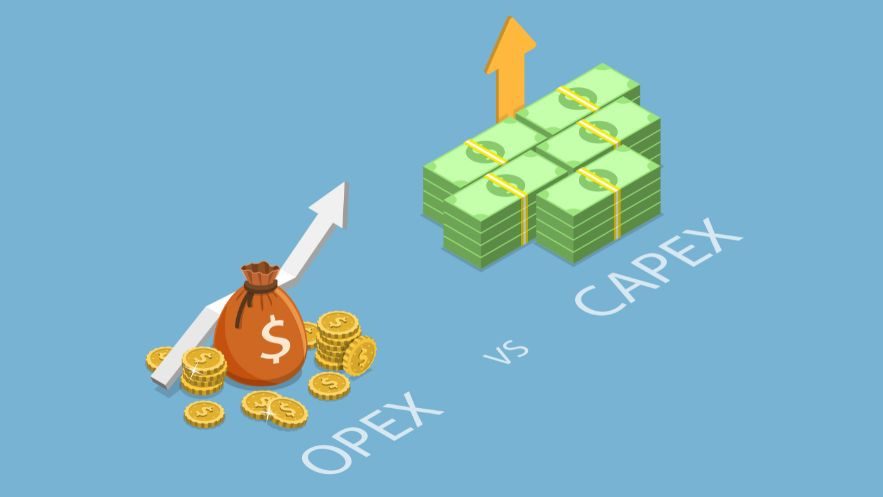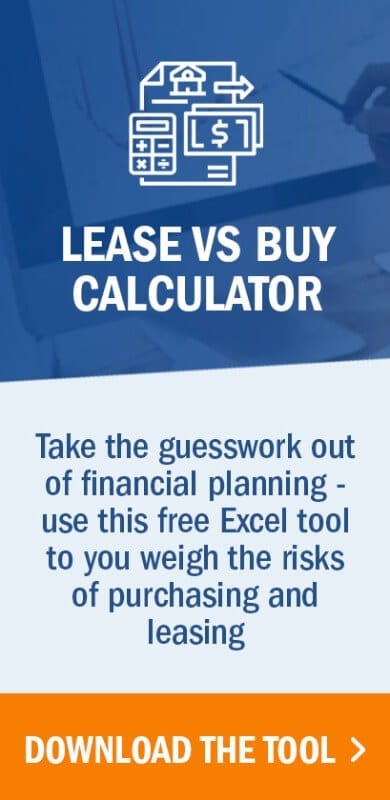Capital budgeting in corporate finance
Capital budgeting is the process used in corporate finance to make decisions about long-term investments, such as real estate, equipment, or software. Simply put, it’s the process of asking: is an asset worth the resources it requires? And what is the best approach – leasing or buying – to acquiring that asset? It’s a high-profile process that’s rapidly evolving with the pace of technology.
Here’s an example:
ABC Co. manufactures medical equipment and is considering whether to open a new facility in the midwest. The new facility will allow ABC Co. to increase production and shorten delivery times to customers in the region. But to get it up and running, ABC Co. will need to acquire the facility and the equipment that will go inside of it.
It will also need to hire employees, renovate the space to fit its needs, and establish a distribution network for the new location. Those upfront costs can easily add up to millions of dollars. It’s up to the finance department to assess whether these upfront costs will pay off for ABC Co. in the long run.
If they make the wrong choice, then the company could end up in serious financial jeopardy. That won’t bode well for shareholders, employees, and customers, all of whom expect the company to be financially prudent. Whether the asset in consideration is an office space or a vehicle fleet, it’s important to follow a rigorous process that emphasizes transparency and accountability. Capital expenditures offer economic benefits, but they can also be major liabilities. Poorly spent capital can have serious long-term ramifications.
Capital budgeting methods
Several methods are commonly used to make capital budgeting decisions:
- Internal rate of return (IRR) – calculation of how long it will take to break even on a capital expenditure
- Payback period (PB) – calculation of how long it will take to recoup the costs of a capital investment
- Net present value (NPV) – calculation of the difference between the upfront costs of an asset and how much cash flow it will generate
- Profitability index (PI) – determination of how much the cost of an expenditure weighs against its anticipated benefits
Each approach has its advantages and limitations. Determining PB is relatively simple, but doesn’t account for cash flows received after the payback period. Using IRR will yield a simple numerical value for the project in consideration, but the calculations required to arrive at that number are highly complex. NPV recognizes that the value of money changes over time, but requires determining a company’s cost of capital and the applicable discount rate. And PI considers all cash flows that a project will generate, but doesn’t account for its sunk costs. Determining the best method can be a complex process in and of itself.
Finance and accounting tools
Capital budgeting isn’t an exact science, so finance managers must rely on systems. These systems aggregate data to help forecast the revenue a capital investment can generate and understand all of the costs. After all, they’re essentially trying to predict the future. There’s no crystal ball for capital budgeting, but there are numerous sophisticated systems that ease the process.
ERPs
Enterprise resource planning systems, or ERPs, are for keeping track of assets, particularly for large, complex organizations. They warehouse data, but typically don’t come with the out of the box features needed for capital planning. Many ERP providers offer capital budgeting modules or packages that can be added to their standard offering. In this instance, the modules or systems are considered a part of the total ERP package, for which the ERP itself acts as a data source.There are also standalone capital planning systems that integrate with ERPs. And finally, some finance professionals take a more manual approach and export the data from the ERPs into Excel. Each of these solutions come with their fair share of benefits and challenges. The value in using an ERP is its wealth of data about a company’s existing assets, which can be leveraged to make predictions about future investments.
Fixed asset systems
Fixed asset systems are used to keep track of items such as vehicles, real estate, computers, and equipment. Accounting departments track the depreciation of these fixed assets, also known as capital assets, for the purposes of financial reporting in compliance with accounting standards. Fixed asset systems already have the capability to perform the complex calculations described earlier in this article. Therefore, systems that have additional forecasting capabilities simplify the capital budgeting process. Fixed asset systems contain historical data on asset depreciation, which can be compared with a project’s budget and used to forecast its impact on the bottom line. And their modeling capabilities allow for comparison between different investment scenarios.
Lease accounting systems
The new lease accounting standards caused the average balance sheet lease liability to increase by nearly 16 times. Operating leases are now represented on the balance sheet, adding another level of complexity to capital planning decisions. Leveraging the insights provided by lease accounting systems can help mitigate some of those complexities.
By looking at the cash flow statements under the new disclosure requirements, finance managers can determine whether they want to restructure lease arrangements when they come up for renewal. If they internally monitor EBITDA metrics, they may decide, in conjunction with renewal, that it’s a good idea to renegotiate the terms of the arrangement such that the lease agreement changes to a financing classification. Lease accounting systems also provide alerts well before a lease comes up for renewal. This can provide ample time to determine whether a lease should be renewed, and how to approach it if so.
Lease administration systems
Similar to lease accounting software, lease administration systems can provide a level of insight into lease obligations that may be difficult to obtain otherwise. If leases are being properly aggregated in a single location, then that data can be used as a single source of truth on what’s being leased, which departments or business units are leasing those assets, and when they’re coming up for renewal. This bird’s-eye view into lease obligations makes it easier to make judgement calls on whether an asset is worth its cost.
Lease vs. buy calculator
Once an asset has been deemed necessary, the next question is whether to lease or buy it. Leasing an asset can be beneficial in cases when an asset needs to be replaced or upgraded frequently, or when the risks of ownership create too much of a financial burden.
On the other hand, buying an asset offers more control over its use and the company’s financial obligations. Lease payments can be unpredictable. If a company plans to keep an asset for a long time, and has the financial stability to take on the upfront costs, buying often makes more sense.
There are five important questions to ask in this process:
- How long will you need an item and how much is it worth?
- What is feasible for your budget?
- Does the asset need to be customized?
- Have you factored in depreciation?
- Have you examined your business’s income statement?
In addition to asking these questions, the next step is to crunch the numbers. LeaseQuery offers an Excel calculator that simplifies this process.
The capital budgeting process is complex and fraught with potential pitfalls. However, companies can leverage the data and technology already at their disposal to mitigate the risks. While new regulations can create some disruption for accounting departments, they also offer an opportunity to gain deeper insights into a company’s financial obligations, and therefore, improve decision-making.






